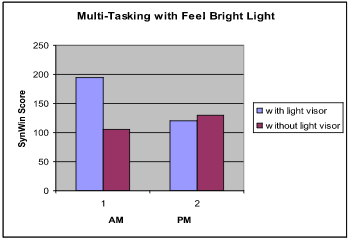The Effects of Timed Exposure to Light Therapy: A Fatigue Countermeasure
Primary Investigators:
Kristena M. Kons & Lauren Fowler, Ph.D.
Weber State University, National Science Foundation
Hypothesis:
- The use of light therapy will adjust the circulating melatonin levels affecting participants’ circadian rhythms so as to phase advance on the morning/day shifts and phase delay on the swing shift.
- Greater improvement in cognitive performance will occur in the morning/day shifts than in the swing shift with the use of light therapy.
Method:
- 11 US Air Force air traffic controllers and 2 weapons controllers were tested over 4 shifts and 4 testing sessions using: a) with and without the Feel Bright Light bright light device; b) salivary melatonin tests; c) the ANAM Synthetic Work Task to test multi-tasking performance similar to job requirements.
- Participants were on rapidly-rotating 5 day/week work schedules:
– mornings (07:00-16:00 hours)
– days (08:00-17:00 hours)
– swings (15:00-23:00 hours) - Melatonin data were collected early in the week and also at the beginning of the day & morning shifts (7:00-8:00 hours) and at the end of the swing shifts (21:00-22:00 hours).
- Fatigue measures were collected before and after bright light treatment.
Results:
- Use of the bright light prior to the work shift had a significant effect by shift -on physiological fatigue (p<.05). Melatonin levels were significantly suppressed during the swing shift, not the morning/day shifts.
- Multi-tasking scores almost doubled with bright light treatment prior to the morning/day shifts (p<.01).
Discussion:
- Bright light treatment resulted in improved cognitive performance.
- The findings demonstrate the feasibility of using an inexpensive and portable bright light device to reduce fatigue-related errors.

